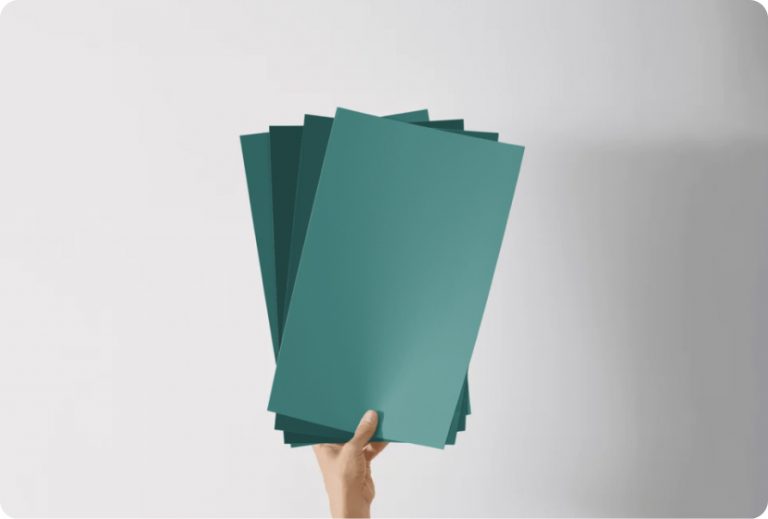If you’re on the lookout for a color that gently enhances your room without making it feel too strong, 2142-40 Dry Sage by Benjamin Moore might just be what you need. I recently had the chance to use this hue in an area that desperately needed a touch of subtle refinement.
What I appreciate most about Dry Sage is how adaptable it is. It’s a muted green with hints of gray, making it unique but incredibly flexible for different styles and rooms. Whether your furniture is modern, rustic, or anything in between, Dry Sage pairs beautifully.
The calmness it brings to a room is undeniable, making it an excellent choice for areas where you want to relax and unwind.
I’ve noticed that this color works well in naturally lit rooms, as the daylight brings out the richness of the hue, adding an extra layer of warmth.
What’s more, when it comes to complementing this shade with other colors, you’ll find it quite accommodating. I mixed it with both warm tones and cooler hues, and it held its ground stylishly each time.
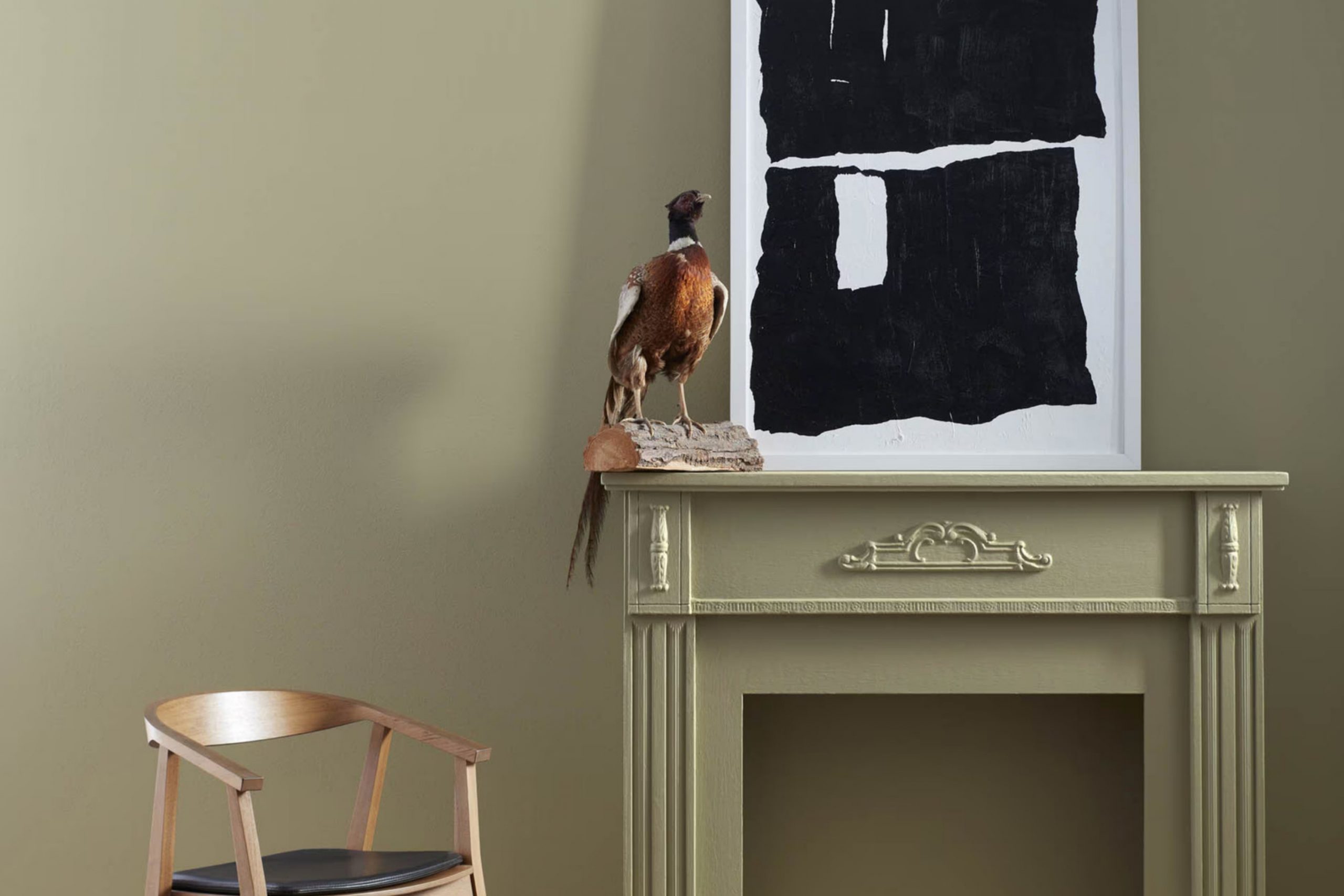
What Color Is Dry Sage 2142-40 by Benjamin Moore?
Dry Sage by Benjamin Moore is a warm, muted green with hints of gray. It provides a calm, natural feel to any room, recalling the soothing qualities of earthy elements and landscapes. This color has a soft adaptability, making it suitable for various living areas such as living rooms, bedrooms, and kitchens. It serves as a gentle backdrop that complements bold and neutral tones alike.
In terms of interior styles, Dry Sage works well with rustic decor, bringing an organic touch to wood-centric designs. It also suits modern and contemporary themes when paired with sleek furniture and metallic accents, creating a balanced, fresh look. For those looking to create a cozy, welcoming atmosphere, this color pairs beautifully with farmhouse and cottage styles.
Dry Sage goes best with natural materials like wood, linen, and leather, enhancing their textures without overpowering them. In rooms with hardwood floors or wooden furniture, it integrates seamlessly, promoting a cohesive aesthetic. When combined with soft textiles like wool or cotton throws, it adds to a comfortable, lived-in feel.
The color also works well with metals such as brass and copper, which introduce warmth and a hint of refinement to the overall decor.
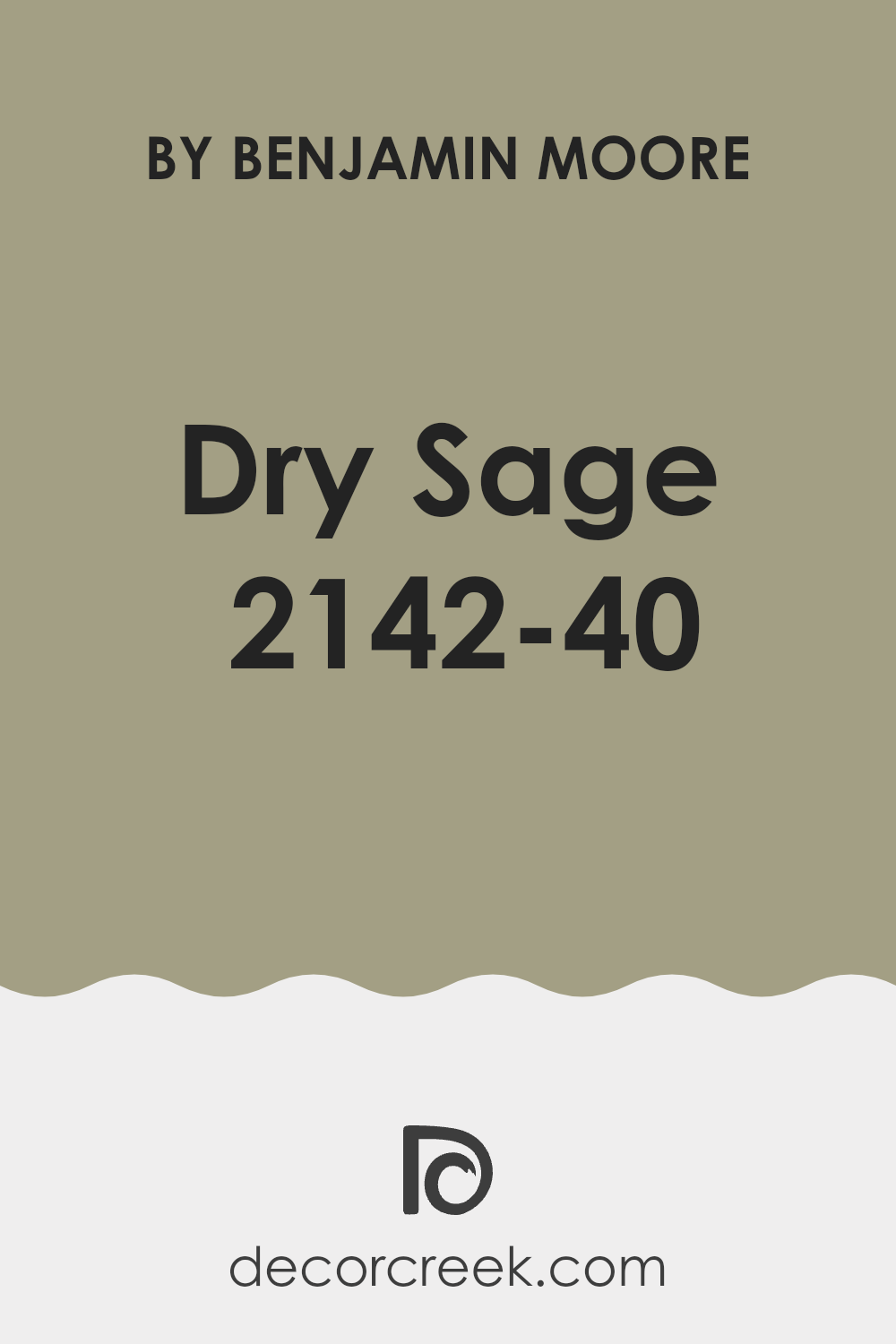
Is Dry Sage 2142-40 by Benjamin Moore Warm or Cool color?
Dry Sage 2142-40 by Benjamin Moore is an adaptable paint color that brings a warm, earthy tone to any room. Often described as a muted green with hints of gray, this color is perfect for creating a cozy yet fresh atmosphere. Its subtle shade allows it to blend well with many decor styles and color palettes, making it an excellent choice for living rooms, bedrooms, or even kitchens.
Since it’s not too bold, it pairs beautifully with both light and dark furniture, adding depth and warmth without being too strong. Homeowners who use Dry Sage find it helps in hiding imperfections on walls and gives rooms a natural, grounded feel.
Additionally, this color works great in homes with a lot of natural light as well as in those with limited light, maintaining its charm under various lighting conditions. It’s an ideal pick for anyone wanting to add a touch of nature-inspired calmness to their home without going too dark or too vibrant.
Undertones of Dry Sage 2142-40 by Benjamin Moore
Dry Sage by Benjamin Moore is an adaptable paint color with a variety of undertones that can subtly change its appearance under different lighting conditions. Undertones are the colors hidden beneath the surface of the paint that influence its overall hue. Some of the undertones found in Dry Sage include pale pink, mint, pale yellow, and light gray, amongst others.
When used on interior walls, the range of undertones in Dry Sage can create a dynamic yet harmonious look, making it suitable for many rooms. For instance, its olive and light green undertones can promote a feeling of nature and freshness, which is especially pleasant in living rooms or studies. On the other hand, its light gray undertone gives it a solid base that can add a sense of calm to bedrooms or offices.
In different types of lighting, the undertones will be more or less noticeable. For example, in bright, natural light, the pale yellow and light green undertones might make the walls seem brighter and more vibrant. In artificial or dim light, the darker undertones like olive and light gray might become more prominent, giving the room a cozier feel.
Understanding the undertones of Dry Sage can help in choosing decor and accessories that complement or contrast with the paint effectively, ensuring that the overall aesthetic of the room is cohesive. Whether you are aiming for a subtle backdrop or a statement wall, considering undertones can greatly enhance your decorating outcome.
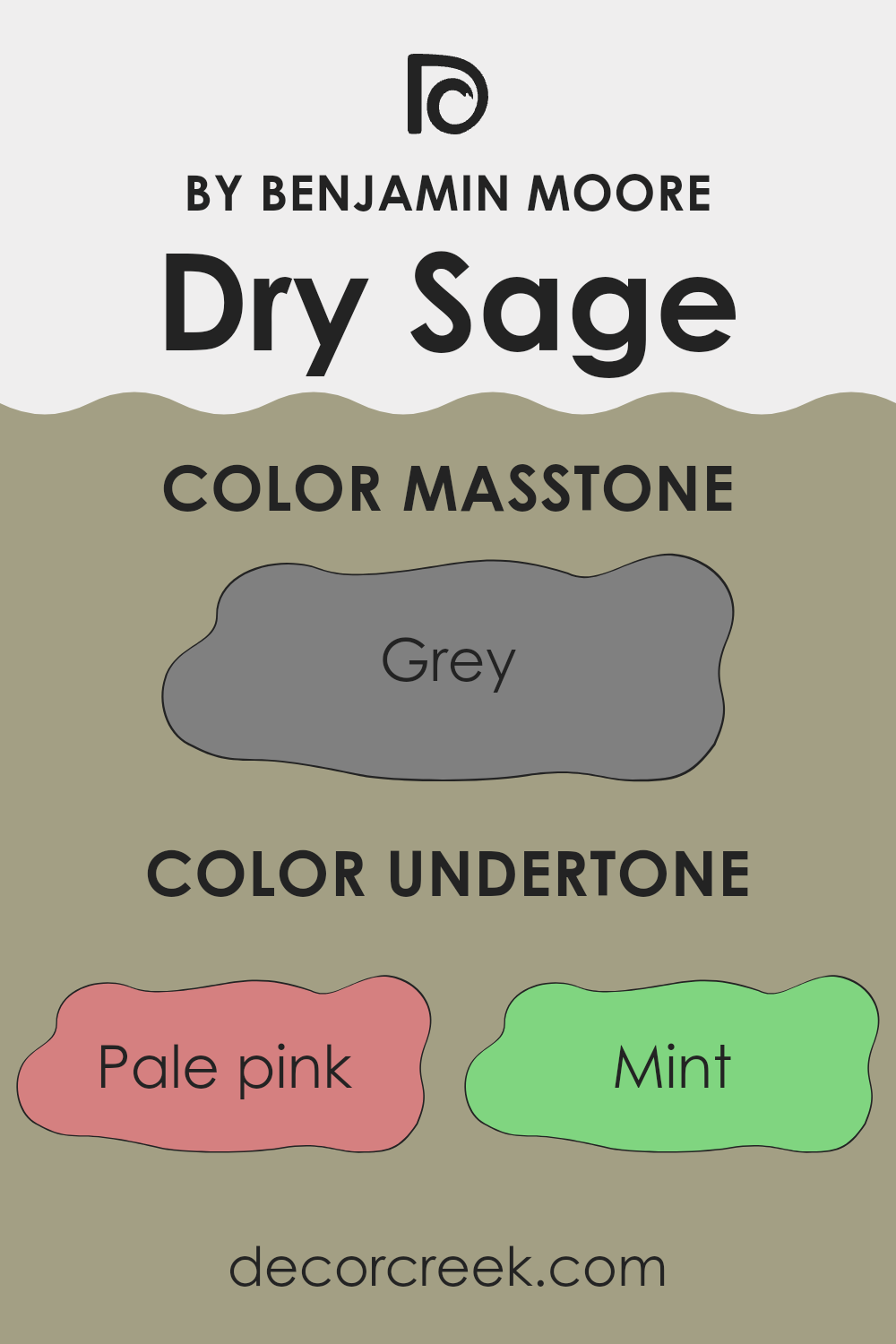
What is the Masstone of the Dry Sage 2142-40 by Benjamin Moore?
Dry Sage 2142-40 by Benjamin Moore is a unique color that matches the masstone grey (#808080). In homes, this shade works wonderfully because it’s neutral and adaptable. It’s perfect for creating a calm atmosphere in any room without making it feel too strong.
Whether used on its own or as a backdrop for brighter colors and various decor styles, it makes rooms feel inviting. This color is very forgiving of daily wear and can hide small imperfections, which is great for busy households.
It pairs well with both modern and traditional furniture, making it a practical choice for those looking to freshen up their home without committing to something too bold. Additionally, this shade is soft enough to work well in bedrooms, living rooms, or offices where you want a subtle touch of color that still maintains a clean and tidy look.
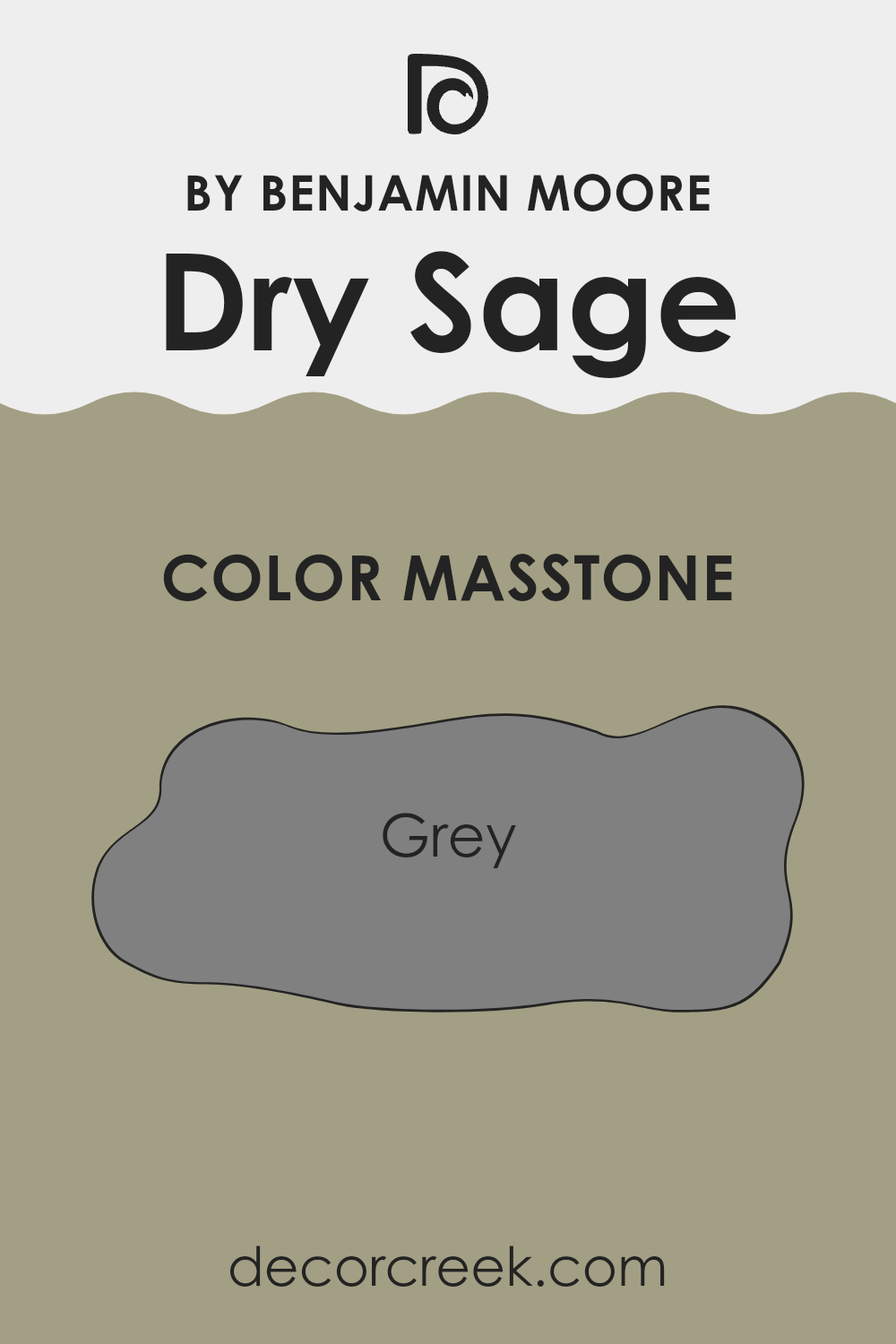
How Does Lighting Affect Dry Sage 2142-40 by Benjamin Moore?
Lighting plays a crucial role in how colors appear in a room. The same paint can look different under various types of light because light sources have different color temperatures and intensities. For instance, the color Dry Sage by Benjamin Moore is a subtle, muted green.
Under artificial light, such as incandescent bulbs, this color may appear warmer and slightly richer than it does in natural light. That’s because incandescent lighting tends to cast a yellow hue, enhancing the yellow undertones in the paint. On the other hand, fluorescent lighting could make Dry Sage look cooler, emphasizing green and blue tones.
When it comes to natural light, the appearance of Dry Sage also changes depending on the direction your room faces:
- North-facing rooms: These rooms get less direct sunlight, which might make Dry Sage appear more subdued and slightly darker. The cooler, indirect light can bring out the color’s more reserved, calm green qualities.
- South-facing rooms: These areas receive a substantial amount of bright, direct sunlight throughout the day. Here, Dry Sage could look lighter and more vivid, bringing out its lively, fresh green aspects.
- East-facing rooms: In the morning, east-facing rooms are bathed in warm sunlight, making Dry Sage look soft and warm. However, as the day progresses, the intensity of the light decreases, and the color may appear more neutral and true to its base.
- West-facing rooms: Rooms that face west enjoy strong evening light, which can make Dry Sage glow warmly in the afternoons but appear cooler and more muted in the morning light.
Overall, the effect of lighting on the color Dry Sage by Benjamin Moore can dramatically affect its appearance, mood, and the atmosphere of a room. Consider test patches in different areas and observe them at various times of the day before making a final decision.
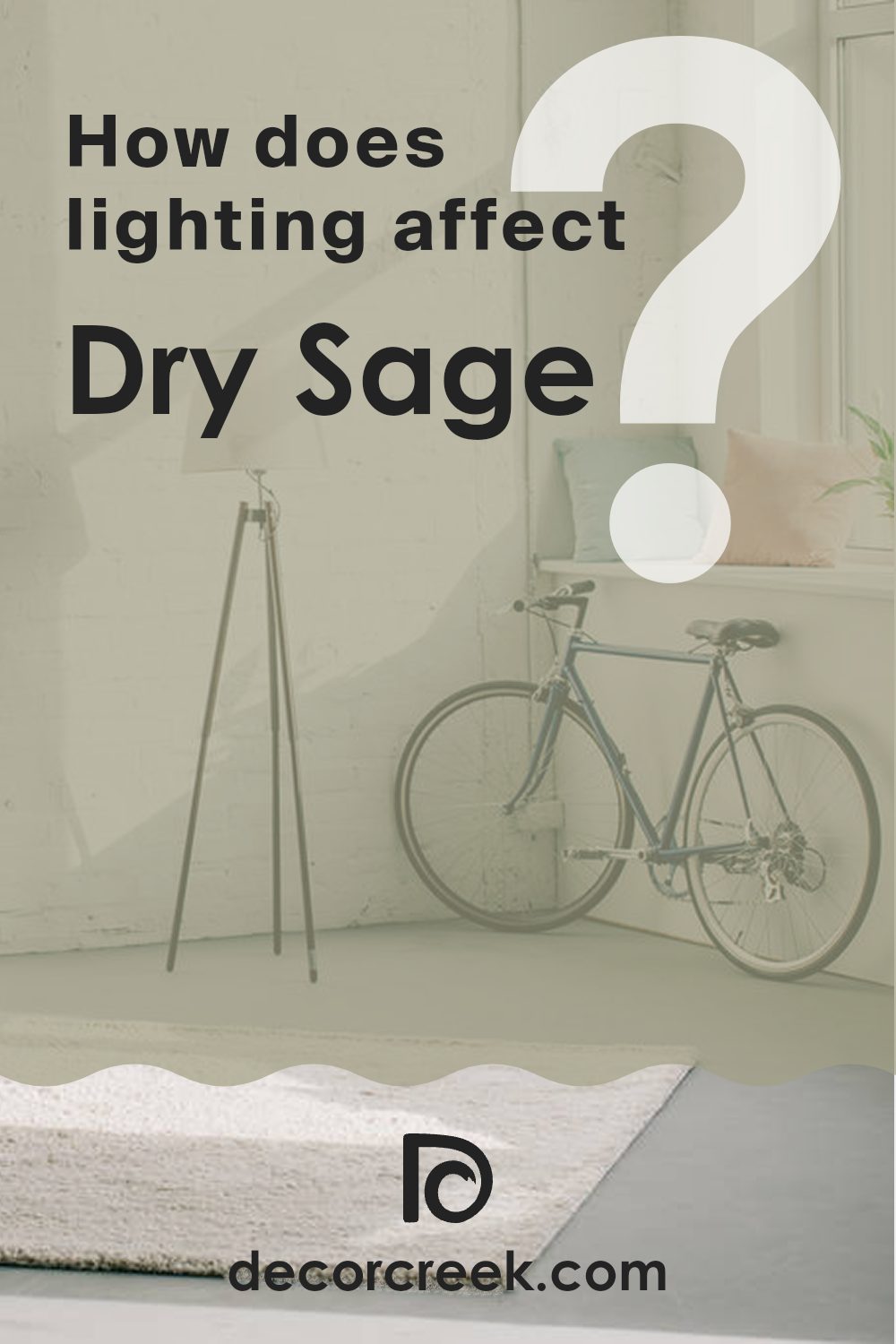
What is the LRV of Dry Sage 2142-40 by Benjamin Moore?
LRV stands for Light Reflectance Value, which measures the percentage of light a paint color reflects back into a room. Think of it this way: if a wall is painted with a very high LRV paint, it will appear lighter because it is bouncing more light back into the room, making the room seem brighter.
On the other hand, a paint with a low LRV absorbs more light, making the room look darker. This value helps in deciding how light or dark a color will look on your walls and how it might affect the mood of a room. Taking the LRV of 34.63 as an example, the color reflects a moderate amount of light.
In practical terms, it means that it is neither too bright nor too dark, creating a balanced look that works well in various lighting conditions. This level of reflectance is adaptable, as it can help to soften a brightly lit room or add some perceived brightness to a darker room, without feeling too strong. It’s particularly useful for painting areas where you want neither a stark brightness nor a deep, heavy feel.
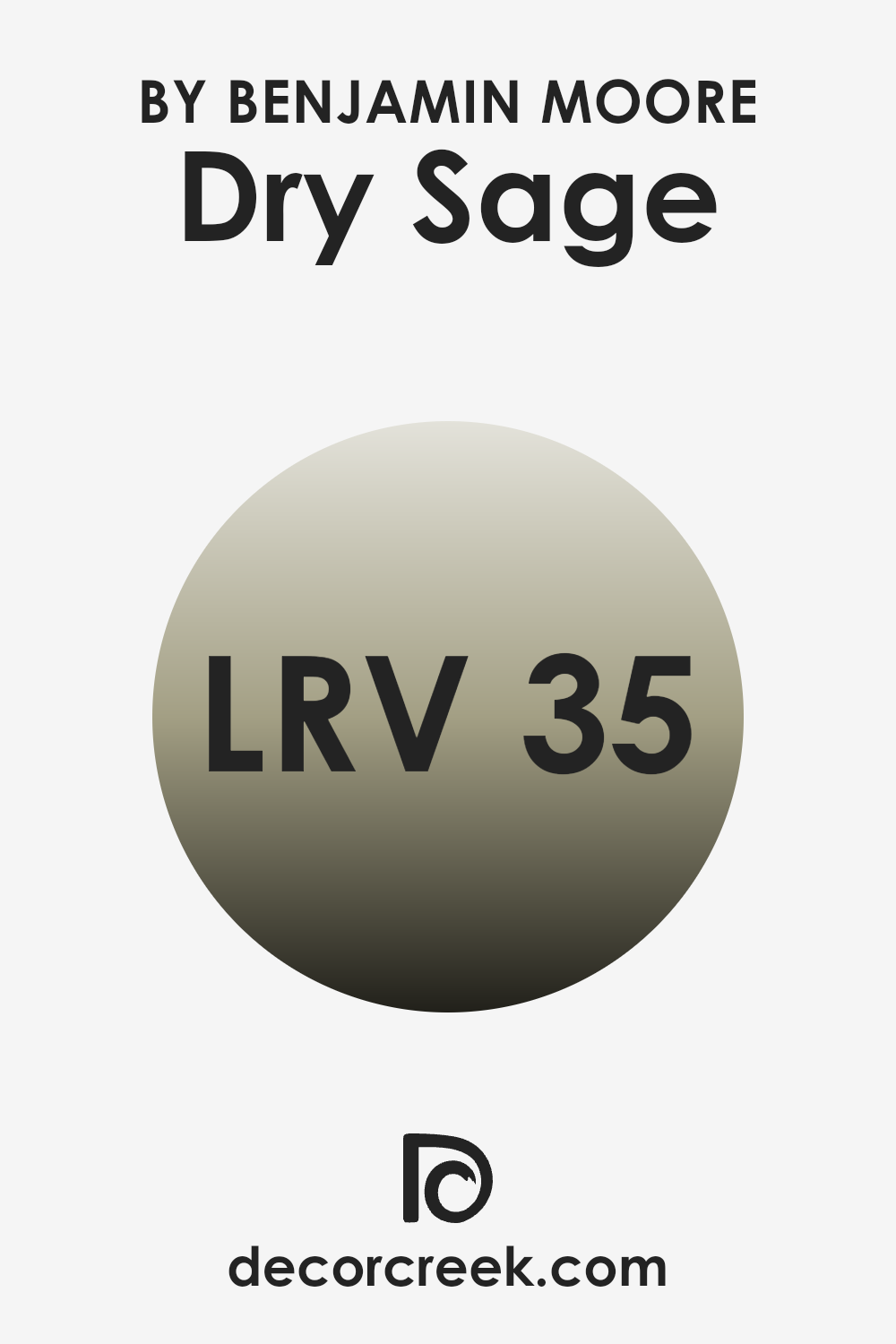
Coordinating Colors of Dry Sage 2142-40 by Benjamin Moore
Coordinating colors are shades that complement or enhance each other when used together in a room, providing a cohesive look that is visually appealing. When selecting coordinating colors, it is important to consider the mood you want to create and the characteristics of the primary color used, in this case, Dry Sage by Benjamin Moore. This muted green shade pairs well with a variety of colors, forming a harmonious color palette that can enhance the ambiance of any room.
Witching Hour (2120-30) is a deep, almost black shade that provides a bold contrast to Dry Sage, making it ideal for accents or statement walls. It adds depth and definition to rooms, working especially well in areas with good natural light or sufficient artificial lighting.
Icicle (OC-60) is a very pale, almost white color with a slight blue undertone that brings a fresh and clean feeling, helping to open up rooms and enhance the airiness when used alongside Dry Sage. Moonlight White (OC-125) is another light shade but with a warmer tone compared to Icicle, offering a subtle warmth that complements the cooler tones of Dry Sage without overpowering it.
Lastly, Sea Wind (OC-139) is a light, muted blue-green that echoes the natural elements of Dry Sage, promoting a calm and cohesive look. This color works beautifully for creating a gentle gradient-themed design. All these colors together provide varied options for designing a room that feels interconnected and thoughtfully styled.
You can see recommended paint colors below:
- 2120-30 Witching Hour
- OC-60 Icicle
- OC-125 Moonlight White
- OC-139 Sea Wind
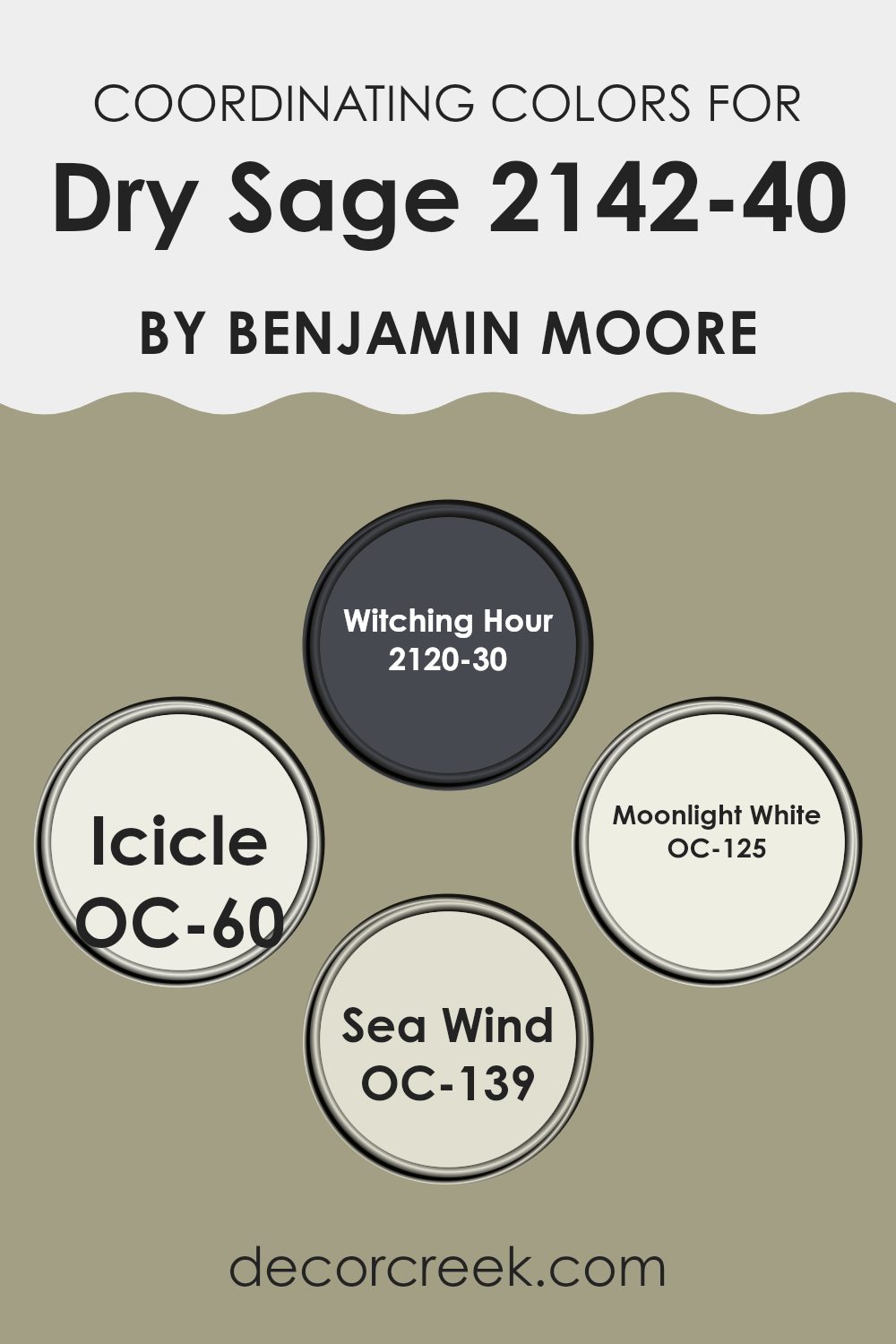
What are the Trim colors of Dry Sage 2142-40 by Benjamin Moore?
Trim colors are essentially the hues chosen for the architectural details of a room such as door frames, crown moldings, baseboards, and window sills. In the context of a wall color like Dry Sage by Benjamin Moore, selecting the correct trim colors can significantly enhance the room’s overall appeal and create a smooth visual flow.
Trim colors usually contrast with the wall color to define and highlight the architectural features, giving the room a polished and finished look. For Dry Sage, a soft and muted green, lighter trim colors such as OC-122 Cotton Balls and OC-146 Linen White are particularly effective in creating a gentle yet distinct contrast that helps brighten the area.
Cotton Balls OC-122 is a pure and crisp white color that brings a fresh and clean energy to a room. It can act as a striking contrast to Dry Sage, highlighting the trim with a freshness that can make the green seem more vibrant and lively. On the other hand, Linen White OC-146 offers a warmer variation of white with a subtle hint of yellow undertones, providing a cozy and inviting feel.
This warm white trim can soften the overall look of a room painted in Dry Sage, lending it a more understated and harmonious appearance. Both shades are effective choices for trims, depending on the atmosphere one wishes to create within the room.
You can see recommended paint colors below:
- OC-122 Cotton Balls
- OC-146 Linen White
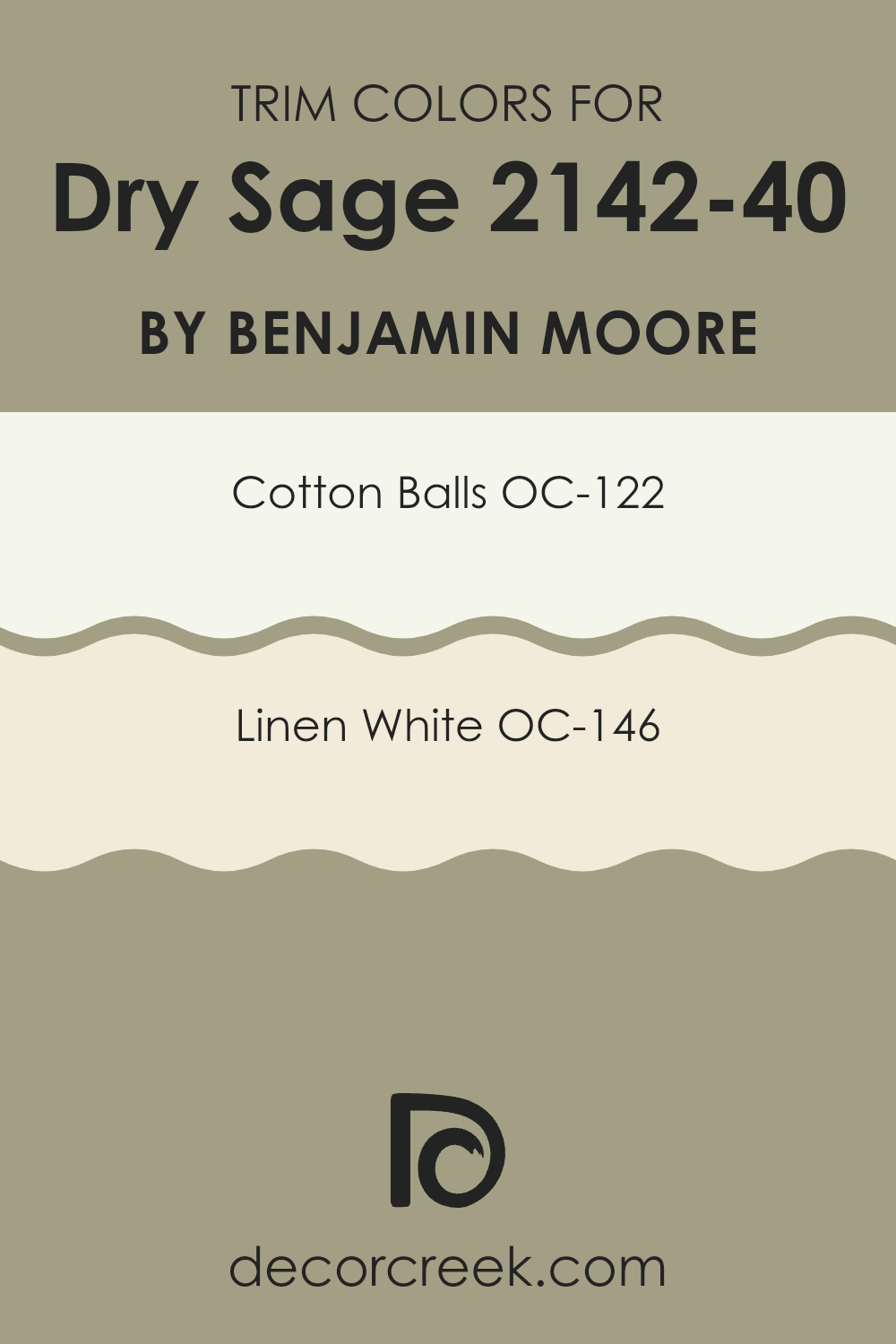
Colors Similar to Dry Sage 2142-40 by Benjamin Moore
Choosing similar colors in a design scheme is a strategic approach that enhances visual harmony and cohesiveness. Colors such as Cypress Green, Thicket, Texas Sage, and Victorian Garden share a close relationship with Dry Sage by Benjamin Moore.
These hues belong to the same palette range, displaying subtle variations that ensure each room maintains a continuous flow without stark contrasts. This kind of color continuity is pleasing to the eye, making rooms appear larger and more connected. It also allows for a unified theme throughout a home or series of rooms, which is aesthetically pleasing.
Cypress Green is a peaceful and refreshing green that brings a hint of nature indoors. Like a walk through a dense forest, it has an earthy and calming effect. Thicket, on the other hand, offers a deeper and richer green, reminiscent of lush undergrowth in a verdant forest. On a similar note, Texas Sage presents a dusty green that hints at the wide-open, rugged landscapes of the Southwest.
Victorian Garden suggests the gentle hues found in traditional English gardens, providing a soft and gentle touch of green that complements ornamental and floral themes perfectly. These colors effectively promote a flowing and interconnected atmosphere, enhancing the overall aesthetic without making the room feel too strong.
You can see recommended paint colors below:
- 509 Cypress Green
- AF-405 Thicket
- 1503 Texas Sage
- 1531 Victorian Garden
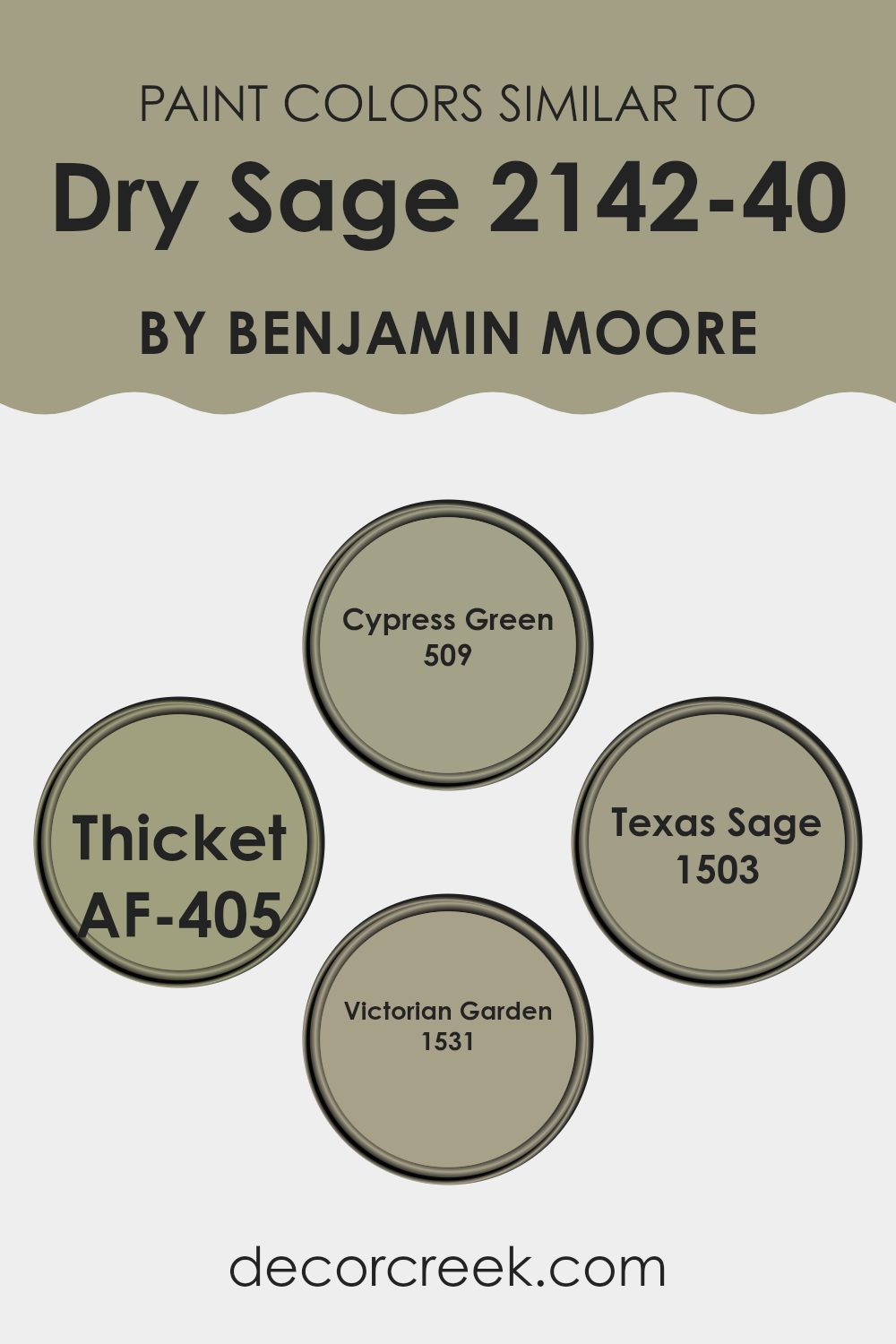
Colors that Go With Dry Sage 2142-40 by Benjamin Moore
Choosing coordinating colors for Dry Sage 2142-40 by Benjamin Moore is important because it helps create a harmonious and appealing ambiance in any room. The right combination of colors not only complements the main hue but also enhances the overall aesthetic of the area.
For instance, pairing Dry Sage with Mediterranean Olive 2142-10 brings a touch of muted depth, as this color is a darker, olive green that adds a rich contrast. Meanwhile, Mountain Moss 2142-30 offers a stronger, earthy vibe which gives a room a grounded feel.
Turtle Green 2142-20 works well as it provides a slightly brighter, yet still subdued green that can lighten the environment subtly. On a much lighter scale, Icicle OC-60 introduces a clean, almost white shade with a hint of blue, providing a refreshing lift to the more subdued greens.
Gray Mirage 2142-50 adds a unique twist, presenting a greyish-green that can act as a neutral, bridging the gap between cool and warm tones. For those looking for a softer approach, November Rain OC-50 is ideal. It’s a gentle grey with green undertones that doesn’t feel too strong, ensuring a smooth visual flow. These color choices allow for flexibility in design while ensuring each room feels cohesive and thoughtfully styled.
You can see recommended paint colors below:
- 2142-10 Mediterranean Olive
- 2142-30 Mountain Moss
- 2142-20 Turtle Green
- OC-60 Icicle
- 2142-50 Gray Mirage
- OC-50 November Rain
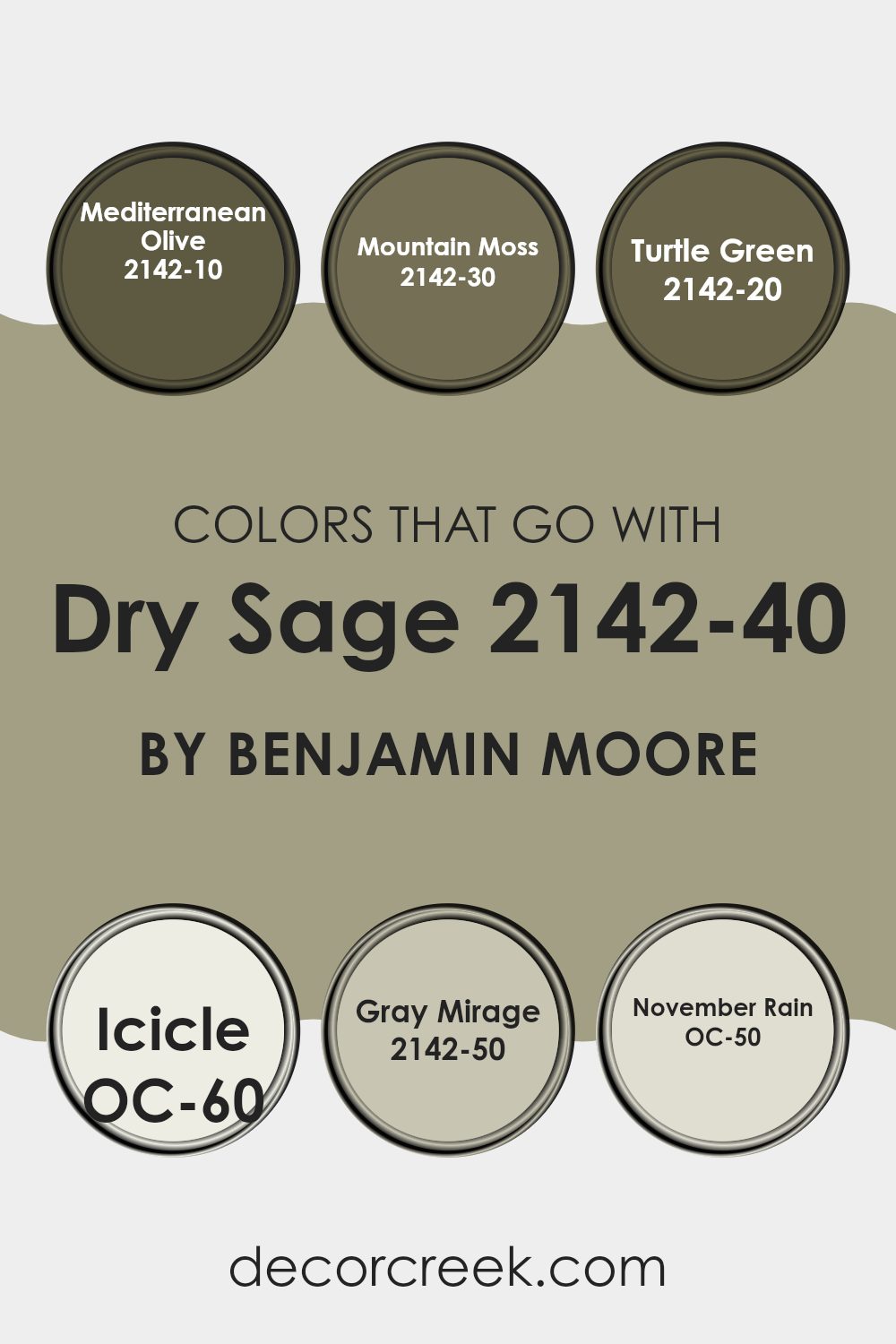
How to Use Dry Sage 2142-40 by Benjamin Moore In Your Home?
Dry Sage 2142-40 by Benjamin Moore is an adaptable green paint that offers a touch of warmth to any room in your home. It can create a cozy atmosphere in living areas and bedrooms or give a fresh look to kitchens and bathrooms. Because the color looks quite natural, it goes well with both modern and traditional decor.
You can use this shade on walls to provide a soft backdrop that complements a wide range of decor, such as wooden furniture and bright fabrics. Painting a feature wall with Dry Sage can also refresh your dining room, highlighting wall art or mirrors.
Moreover, this color is great for cabinets and bookshelves if you want a subtle hint of color without making the room feel too strong. You can even use it outside, for example, on shutters or trim, to blend the exterior of your home into its natural surroundings. With its soft and earthy hue, Dry Sage provides a calming effect, making it a perfect choice for creating a cozy home environment.
Dry Sage 2142-40 by Benjamin Moore vs Thicket AF-405 by Benjamin Moore
The colors Dry Sage and Thicket by Benjamin Moore are both inspired by nature, but they have distinct tones. Dry Sage is a soft, muted green with gray undertones, making it a subtle choice for creating a cozy and welcoming room.
It works well in areas that get a lot of light, as the light brings out the complexity of the color. On the other hand, Thicket is a deeper, more intense green. This color has a strong presence and can add a rich, lush feel to a room.
It’s great for accent walls or areas where you want to make a bold statement. While Dry Sage blends into a room gently, Thicket stands out and catches the eye more directly. Both colors would complement natural materials like wood or stone, enhancing a home with organic textures.
You can see recommended paint color below:
- AF-405 Thicket
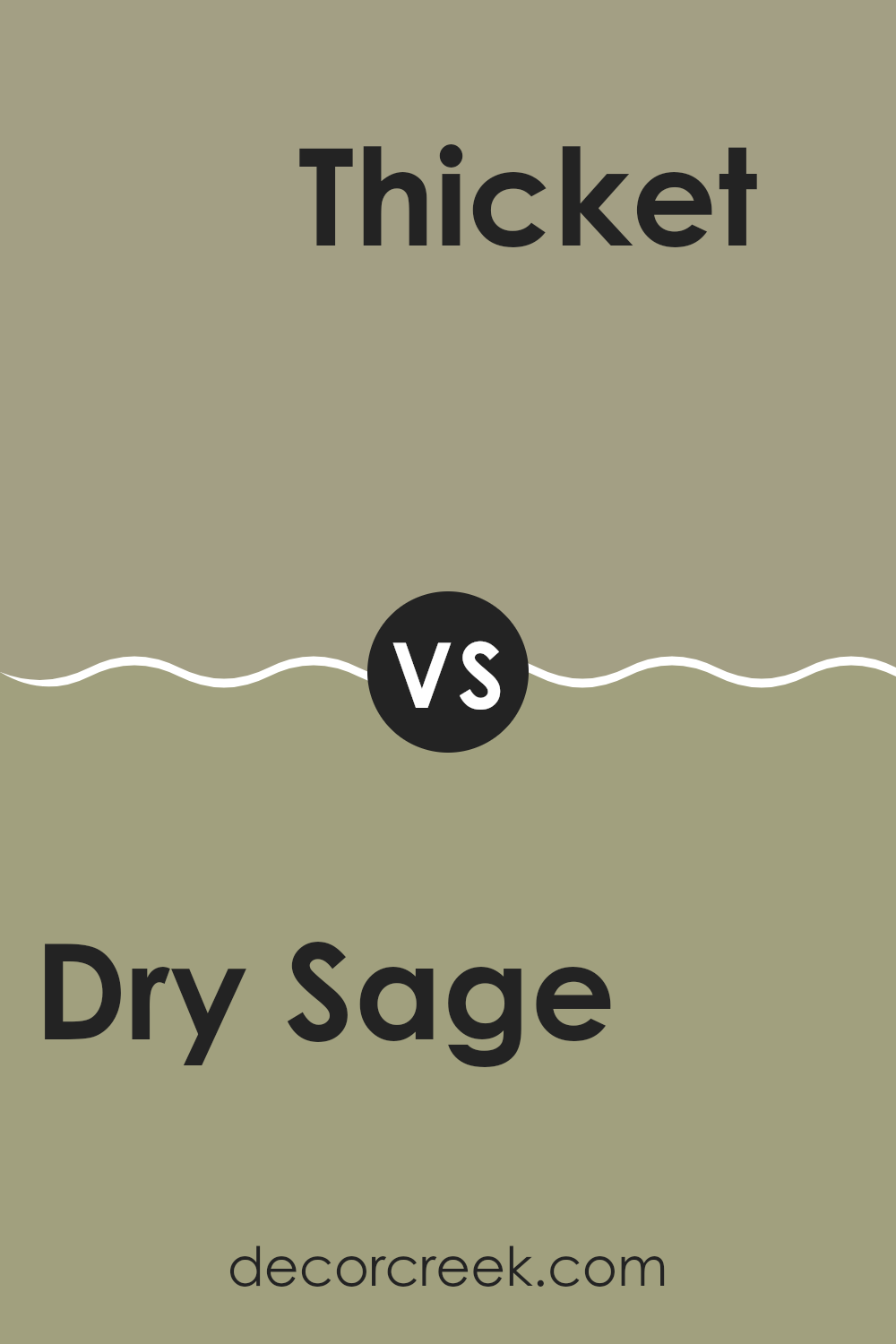
Dry Sage 2142-40 by Benjamin Moore vs Cypress Green 509 by Benjamin Moore
Dry Sage and Cypress Green by Benjamin Moore are two distinct shades of green, each offering its own unique aesthetic. Dry Sage is a soft, muted green with gray undertones, creating a subtle and soothing effect. It’s perfect for rooms where you want a calm, understated look.
On the other hand, Cypress Green is a deeper, richer green. This color is bolder and more striking, making it ideal for those looking to make more of a statement in their room.
While Dry Sage might be better suited for a bedroom or living area due to its gentle nature, Cypress Green could be a great choice for an accent wall or in areas like the dining room where you wish to add a touch of elegance and depth. Overall, the choice between these two would depend on the atmosphere you aim to achieve in your room.
You can see recommended paint color below:
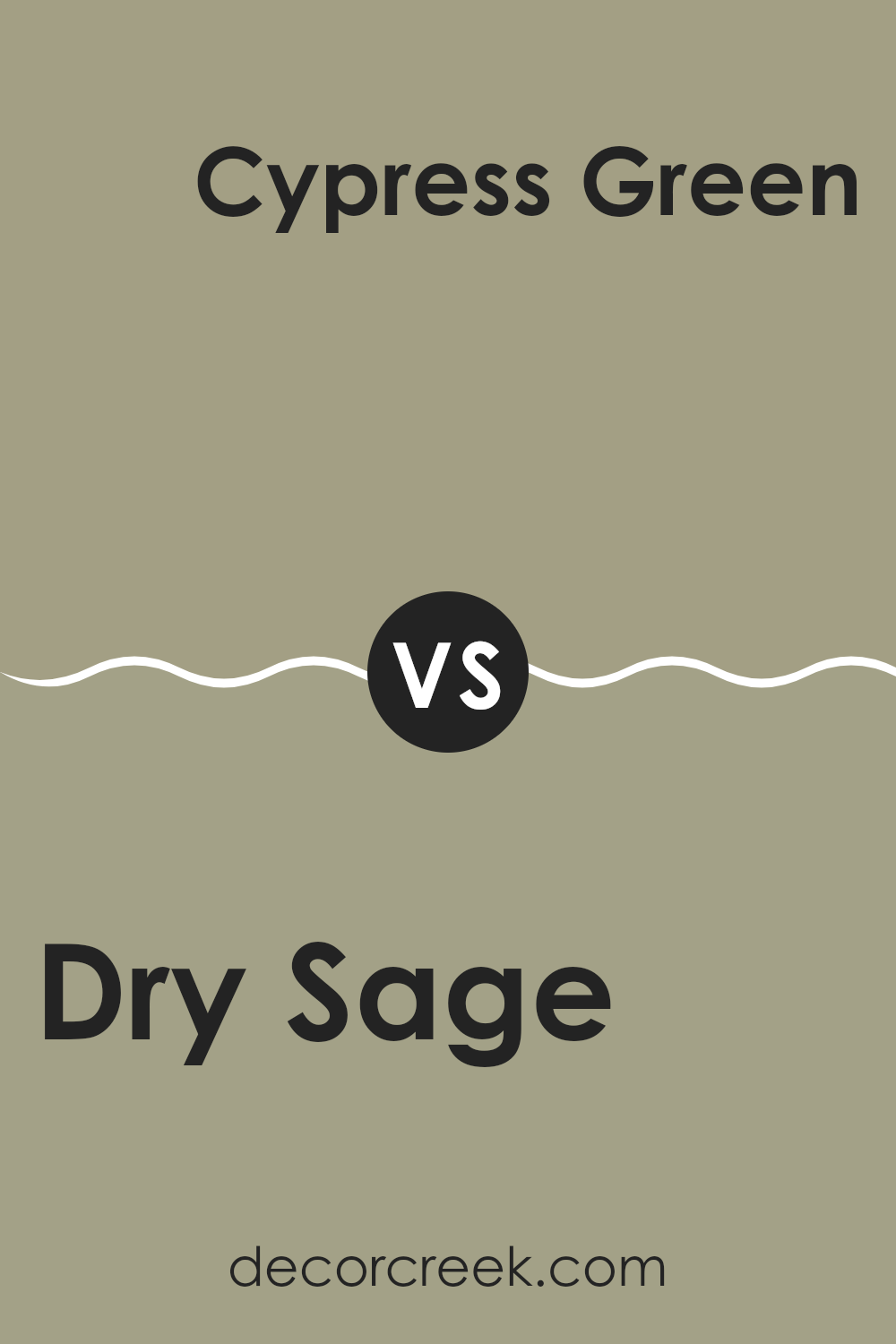
Dry Sage 2142-40 by Benjamin Moore vs Texas Sage 1503 by Benjamin Moore
Dry Sage and Texas Sage by Benjamin Moore are both inspired by natural earth tones, but they present unique shades that can impact the feel of a room differently. Dry Sage is a muted green with gray undertones, giving it a subtle and calming presence.
It works well in rooms where you want a hint of color without making it feel too strong. On the other hand, Texas Sage leans more towards a lighter, airier gray with a touch of green. This color reflects more light, making it a good choice for smaller or darker rooms to help them appear brighter and more open.
Both colors can create a cozy atmosphere, but Dry Sage’s deeper tone might be better suited for a more intimate setting, while Texas Sage provides a fresher look. When choosing between them, consider the room’s size, lighting, and the mood you want to create.
You can see recommended paint color below:
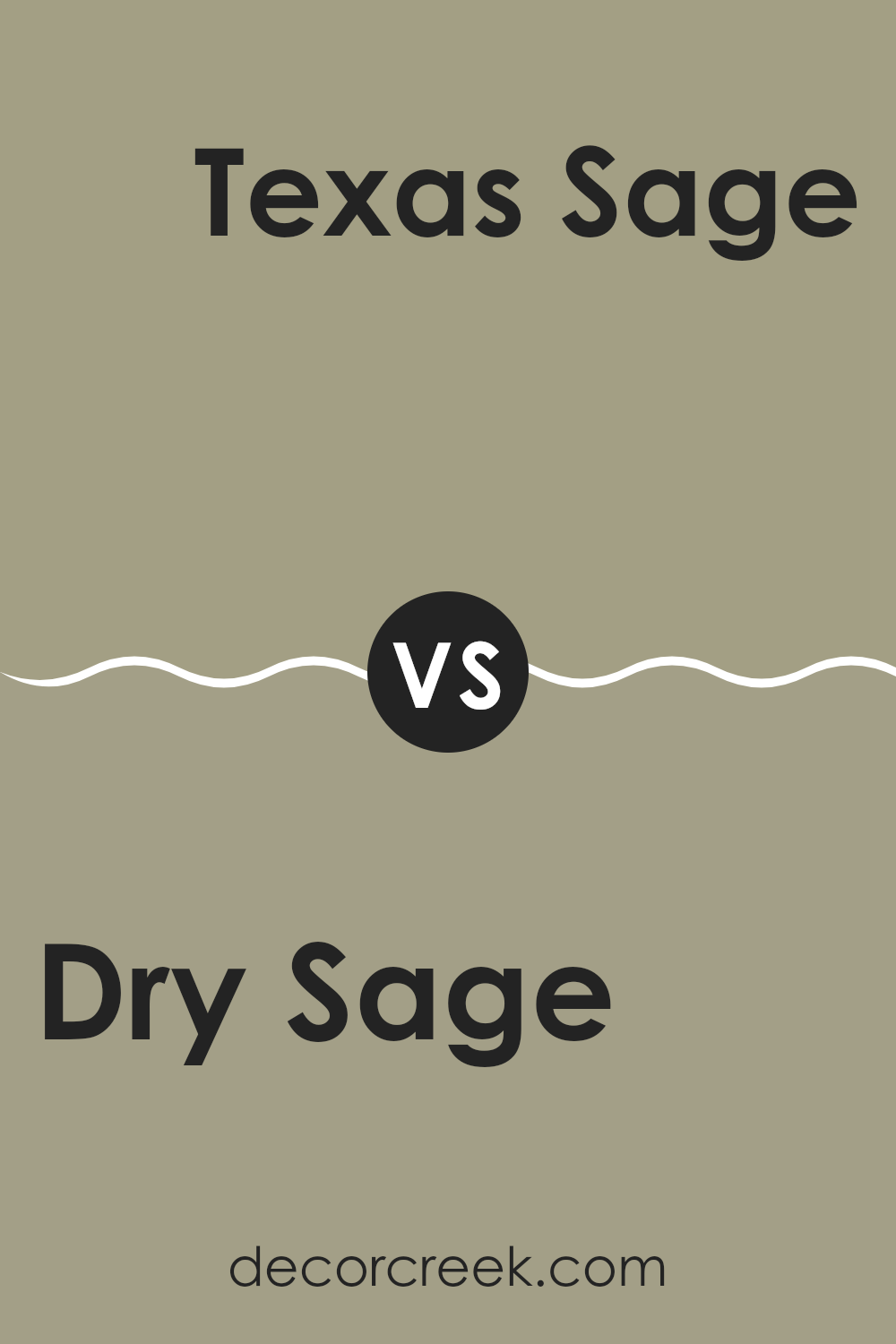
Dry Sage 2142-40 by Benjamin Moore vs Victorian Garden 1531 by Benjamin Moore
Dry Sage and Victorian Garden are both colors by Benjamin Moore, each presenting unique tones. Dry Sage is a soft, muted green with a grayish undertone, giving it a subtle, natural look. It creates a calm and soothing atmosphere, ideal for rooms where you want a touch of nature without making the color feel too strong.
On the other hand, Victorian Garden is a slightly brighter color with more vibrancy. It leans towards a pastel blue with hints of gray, offering a refreshing and airy feel. This color works well in areas that aim to feel open and light.
While both colors are quite muted and not too bold, they distinctly bring their own character to rooms—Dry Sage leaning towards earthiness and Victorian Garden towards a breezy, open vibe. Either color is adaptable for styling with various decor styles, and both instill a gentle, welcoming ambiance in any room.
You can see recommended paint color below:
- 1531 Victorian Garden
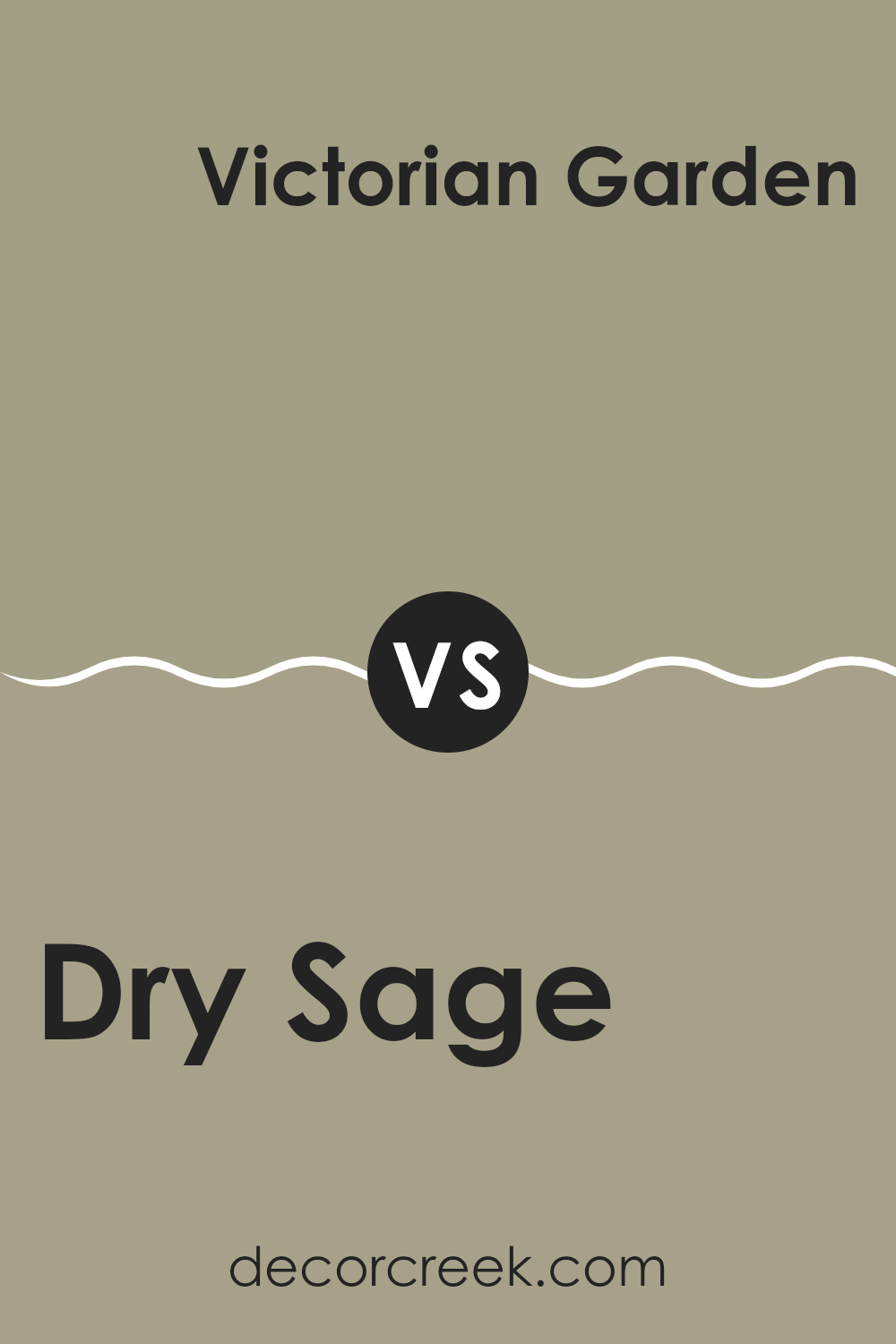
As I finish looking at “2142-40 Dry Sage by Benjamin Moore,” it’s clear that this paint color is pretty special. Dry Sage has a soft, green shade that makes any room feel cozier and more welcoming. It’s not too bright or too dark, so it fits just right in places like the living room or the bedroom, where you want to feel relaxed.
This color also pairs well with others. You can match it with soft whites or light browns, and it still looks great! After reading about Dry Sage, I think it’s a good choice for someone wanting to refresh their home without making things too flashy.
It’s like giving your room a quiet, friendly smile, making it warmer and more like home. So, if you’re thinking about a new color for your room and you want something calm and pretty, Dry Sage could be just what you need. It’s a color that makes any room nicer without trying too hard, just like a good friend that fits perfectly into your life.
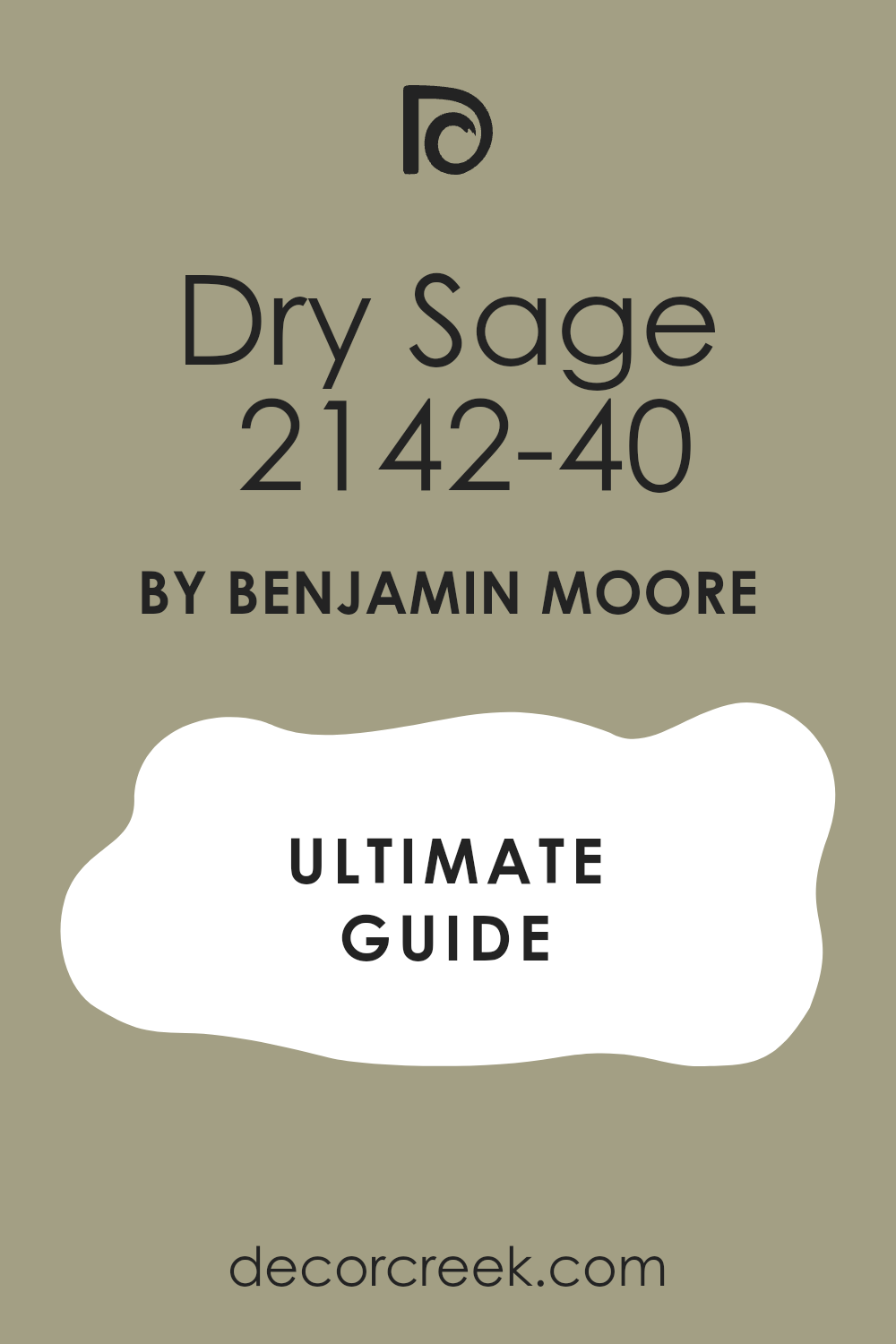
Ever wished paint sampling was as easy as sticking a sticker? Guess what? Now it is! Discover Samplize's unique Peel & Stick samples.
Get paint samples



